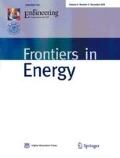Abstract
This paper presents the selected power quality (PQ) indicia of a wind generator and a photovoltaic installation considered to be the representative of medium voltage and low voltage distribution grids. The analysis of measured values suggests that the decrease in PQ is a case of specific combination of distributed generation, grid parameters and load behaviour. Modern generators have a limited impact on PQ. On the other hand, fluctuations in power generation are regarded as an emerging PQ indicator. The growing number of distributed renewable installations causes stochastic, variable, and hardly predictable power flows in the distribution grid. The nature of fluctuations in wind and solar generation is different. In both cases, new indexes for the quantification of fluctuations are needed and are yet not standardised. Proper assessment of these fluctuations enables definition of useful fluctuation limits and rules for optimal storage system integration.
Similar content being viewed by others
References
Parliament E. Directive 2009/28/EC of the European Parliament and the Council on the promotion of use of energy from renewable sources, 2009
By EU. Directive 2001/77/EC of the European Parliament and the Council on the promotion of electricity produced from renewable energy sources in the internal electricity marked, 2001
Foxpenner P. Smart Power: Climate Change, the Smart Grid and the Future of Electric Utilities. Washington: Island Press, 2010
Bollen M H, Hassan F. Integration of Distributed Generation in the Power System. John Chichester: Willey-IEEE Press, 2011
CIGRE. Impact of increasing contribution of dispersed generation on the power system. CIGRE Study Committee No 37, Final Report, 1998
IEEE Standard 1547. IEEE Standard for interconnecting distributed resources with electrical power systems. Institute of Electrical & Electronics Engineers Inc, 2003
BSI. Standard EN50438–2013. Requirements for the connection of micro-generators in parallel with public low-voltage distribution networks, 2013
Baggini A. Handbook of Power Quality. Hoboke: John Willey & Sons, 2008
Caramia P, Carpinelli G, Verde P. Power Quality Indices in Liberalized Markets. Hoboke: John Willey & Sons, 2009
Janik P. Photovoltaic Power Generation Assessment Based on Advanced Signal Processing and Optimisation Techniques. Wroclaw: Publishing house of Wroclaw University of Science and Technology Wroclaw, 2014
CENELEC EN 50160–2010. Voltage characteristics of electricity supplied by public electricity networks
Standard IEC61000-2-2–2002. Electromagnetic compatibility (EMC)–Part 2-2: environment-compatibility levels for low-frequency conducted disturbances and signalling in public low-voltage power supply systems
Standard IEC61000-2-4–2002. Electromagnetic compatibility (EMC)–Part 2-4: environment-compatibility levels in industrial plants for low-frequency conducted disturbances
Standard IEC61000-2-12–2002. Electromagnetic compatibility (EMC)–Part 2-12: environment-compatibility levels for lowfrequency conducted disturbances and signaling in public medium-voltage power supply systems
Standard IEC61000-4-7–2010. Electromagnetic compatibility (EMC)–Part 4-7: testing and measurement techniques-general guide on harmonics and inter harmonics measurements and instrumentation, for power supply systems and equipment connected thereto
Standard IEC 61000-4-15–2010. Electromagnetic compatibility (EMC)–Part 4-15: testing and measurement techniques-Flickermeter-Functional and design specifications
Standard IEC61000-4-30–2008. Electromagnetic compatibility (EMC)–Part 4-30: testing and measurement techniques–Power quality measurement methods
The windpower. 2016–10–28, http://www.thewindpower.net/turbine_en_29_vestas_1800
Standard IEC61000-3-2–2014. Electromagnetic compatibility (EMC)–Part 3-2: limits for harmonic current emissions (equipment input current≤ 16 A per phase)
Standard IEC61000-3-3–2013. Electromagnetic compatibility (EMC)–Part 3-3: limits–limitation of voltage changes, voltage fluctuations and flicker in public low-voltage supply systems, for equipment with rated current ≤ 16 A per phase and not subject to conditional connection
Author information
Authors and Affiliations
Corresponding authors
Rights and permissions
About this article
Cite this article
Janik, P., Kosobudzki, G. & Schwarz, H. Influence of increasing numbers of RE-inverters on the power quality in the distribution grids: A PQ case study of a representative wind turbine and photovoltaic system. Front. Energy 11, 155–167 (2017). https://doi.org/10.1007/s11708-017-0469-3
Received:
Accepted:
Published:
Issue Date:
DOI: https://doi.org/10.1007/s11708-017-0469-3




